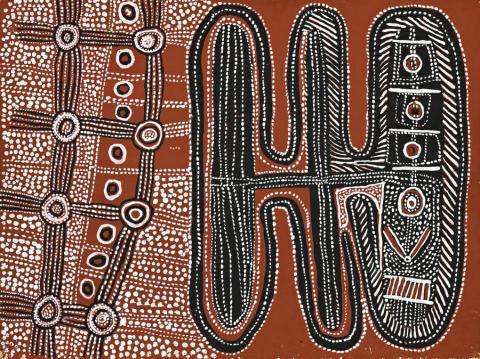UNTITLED (OLD MEN'S STORY), 1972
UTA UTA TJANGALA
synthetic polymer powder paint on composition board
46.0 x 61.0 cm
inscribed verso: Stuart Art Centre cat. 12032
Painting 32, consignment 12 to the Stuart Art Centre, Alice Springs
Private collection, Adelaide
Sotheby's, Melbourne, 28 June 2000, lot 69
Private collection, Melbourne
Tjukurrtjanu: Origins of Western Desert Art, The Ian Potter Centre: National Gallery of Victoria, Melbourne, 30 September 2011 - 12 February 2012; Musée du Quai Branly, Paris, 9 October 2012 - 27 January 2013
Bardon, G., and Bardon, J., Papunya: A Place Made After the Story - The Beginnings of the Western Desert Painting Movement, The Miegenyah Press, Melbourne, 2004, painting 341, p. 387 (illus.)
Ryan, J. and Batty, P., Tjukurrtjanu: Origins of Western Desert Art, National Gallery of Victoria, Melbourne, 2011, p. 139 (illus.)
This work is accompanied by a certificate of authenticity from Stuart Art Centre.
Old Men's Stories or Dreamings are a recurring subject in the paintings of Uta Uta Tjangala. The best known of these relate to Yumari, an important ancestral site in his mother's country which is linked to Uta Uta's conception place at Ngurrapalangu through Yina, the ancestral man (Myers, F.R., Painting Culture: The Making of an Aboriginal High Art, Duke University Press, Durham and London, 2002, p.113). However, while the documentation accompanying this painting does not relate it directly to the Old Man Yina, there is a reference in the work to life at Papunya as observed by the artist. According to Geoffrey Bardon, when Uta Uta painted Old Man's Story in May/June 1972, there were two old Pintupi men living at Papunya. Each man only had one leg and both used crutches to support themselves (Bardon and Bardon, 2004:387). The overlaying of ancestral narratives with contemporary or historical events is a feature of the work of many Aboriginal artists, from Mick Namarari Tjapaltjarri at Papunya to Mawalan Marika in Arnhem Land and to Rover Thomas in the east Kimberley.
The composition of Old Man's Story is characteristic of Uta Uta's paintings. The picture is divided in two parts: one featuring the Pintupi grid of roundels, which in this case represent campfires, joined by travelling lines; the other half of the painting features a prominent glyph which here represents the two old men decorated in ceremonial body paint. For a painting by the artist that features a similar composition see Medicine Story (version 3), 1971, in the collection of John and Barbara Wilkerson, illustrated in Bardon and Bardon, 2004, p.306, painting 248, and in Benjamin, R., and Weislogel, A.C., (eds), Icons of the Desert: Early Aboriginal Paintings from Papunya, Herbert F. Johnson Museum of Art, Cornell University, New York, 2009, p. 88, cat. 8.
WALLY CARUANA
